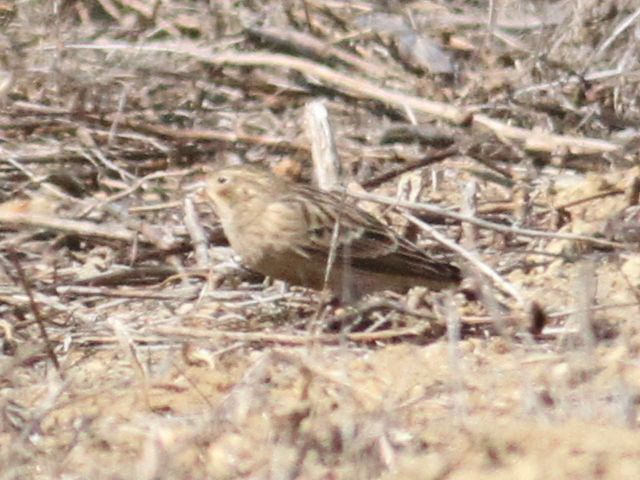[All photographs copyright, Gary Nunn 2012] – I found this flighty and uncooperative Chestnut-collared Longspur Calcarius ornatus at the Fiesta Island, Mission Bay dog run. It was associating with a handful of Horned Lark, by chance the first group I encountered, but proved very difficult to approach. After several attempts I managed some distant photographs, stationary as well as fly by, shown here heavily cropped and of barely tolerable quality. In flight it made a weak chuckling or rattling call which was difficult to pick out among the many noisy Horned Lark.
Photographed in flight this longspur showed a moderate amount of white on the tail. In the bright mid day light I had trouble picking it out in flight from the Horned Larks that flushed from the ground with it although it did fly more directly without sharp turns. In the photographs below white coloration can be readily seen on the two outer pairs of rectrices r5 and r6. On the second photo the white coloration seems to be more extensive near the base of the tail which I believe is probably the white inner web of rectrix r4 (this tail feather also has a complete black outer web).
From the back view this longspur is quite warmly colored, even in my over-exposed photograph. Although hard to see the crown is peppered with dark brown feathers and the supercilium is pale buff with a slightly darker buff auricular area. Down the back there is a pair of paler brace marks which stand out among the dark centered feathers of the upper parts. The tertials also appear quite dark colored with pale buff edge coloration. Both the greater and median secondary coverts have standout pale tipped edges which can also be seen in the flight photographs above along with white lesser secondary coverts.
Observing this longspur feeding on the ground I was pretty confident eliminating McCown’s and Lapland Longspur. McCown’s is short-legged, almost legless looking in fact, usually crouched tight against the ground, and has a robust larger pink bill. Lapland Longspur can usually be relied on to run around actively on its long legs and show off the white belly as it stands alert looking high off the ground. Chestnut-collared Longspur is kind of intermediate in GISS walking moderately sluggishly with medium length legs visible. The much rarer alternative of Smith’s Longspur, unrecorded in San Diego County, would be more richly buff colored overall with a dark framing of the auricular on the face, as well as fine abundant streaks on the chest. This species also prefers grassland habitats over the desolate open wastelands popular with the other three longspur species. Many thanks to Jay Keller, Curtis Marantz, Kurt Radamaker and Paul Lehman for useful feedback on these photographs.





